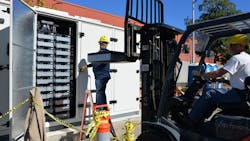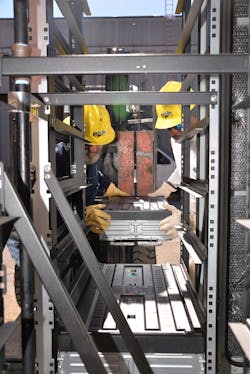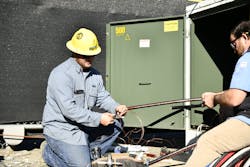Chattanooga EPB Microgrid Serves Emergency Response Center
Established in 1935 as an independent board of the City of Chattanooga, Tennessee, U.S, EPB provides energy and connectivity services to approximately 200,000 homes and businesses throughout its 600-sq-mile (1554-sq-km) service area. During the last decade, EPB and the city established a strong track record of working together closely to deploy smart city technologies, support economic development, close the digital divide and keep Chattanooga on the cutting edge through leading fiber-optic services and highly reliable energy.
In 2019, the City of Chattanooga launched a regional resiliency council to develop preparations for increasing severe weather events and grow the number of green projects under city management. At the same time, EPB was making plans to increase power reliability by investing in distributed energy resources (DERs) and reducing wholesale power costs. Soon after, tornadoes devastated neighborhoods east of the city on Easter 2020, placing more urgency on the need to provide continuity and ensure swift response if another emergency happened.
With the shared goals of protecting essential community assets, EPB and the city launched Power to Protect, a project focused on developing a microgrid at the Chattanooga Police Services Center and Fire Department administrative headquarters. These facilities operate 24/7/365, and include additional services such as a fire station, SWAT team, homicide, radio control center, city camera surveillance and other critical communication infrastructure.
Emergency Preparedness
The city previously installed a large solar generation site for its wastewater treatment plant and wanted to expand its solar strategy using available roof space during a roof replacement at the Police Services Center, to ensure the location would maintain operations if electricity to the building were interrupted during a weather or other emergency. Backup generators for the city’s facilities were only sufficient to provide partial backup power for limited periods of time.
Smart Grid Technology
When planning began for the Power to Protect microgrid, one goal was to provide emergency power to multiple buildings that did not have emergency generators. EPB’s existing electric grid already included multiple layers of automated restoration afforded by the smart grid.
EPB’S smart grid has 1200 smart switches, sensors and other devices on a 9000-mile (14,484-km) fiber-optic backbone to reroute power automatically when a disruption is detected. The police and fire microgrid campus is served by two sources to preserve power to the location. Given the reliability of the smart grid, the microgrid’s design accounted for these initial connections first. If they failed, EPB system operators would remotely dispatch the microgrid from the distribution center, making the microgrid the third line of defense for this essential community asset — and only if the outage could not be resolved by the smart grid.
Investments And Benefits
Power to Protect began with an EPB evaluation of the site for maximum power requirements. To support needs during an outage that would necessitate transitioning to microgrid power, EPB sourced a new 500-kW/1100-kWh front-of-meter battery. Separately, the city invested in a 200-kW behind-the-meter diesel generator and 155 kW of solar panels.
The dual behind-the-meter and front-of-meter structure enables both entities to begin recouping their investments. In addition to continuing emergency services during an outage, the front-of-meter battery system enables EPB to shave peak load during extremely hot or cold weather, reducing peak demand charges and allowing EPB to recoup the investment in a faster manner. (EPB does not shave peak load if severe weather is in the forecast; batteries are charged to capacity, so they are prepared for an emergency.)
Behind-the-meter solar panels regularly reduce the amount of metered energy required for the building, lowering the city’s EPB bill by roughly 20% monthly.
Operating Modes
During normal operations, the police and fire microgrid battery operates in grid-following mode, meaning it is connected to EPB’s smart grid, which keeps the battery fully charged and ready when needed. If EPB’s smart grid becomes unavailable and the automated restoration cannot resolve the outage, the microgrid transitions to island mode and the battery supplements what solar cannot produce, supports full load when no solar is available or charges when solar generation is greater than the site load.
The solar component of the microgrid follows the operations of the facility, whether it is operating on grid or battery. Solar generation also is given priority, so full output is used whenever possible and curtailed when output is greater than load.
The Challenges
Having enjoyed decades of working closely together, the city and EPB provided the foundation for Power to Protect to proceed smoothly with close communication and collaboration. Unfortunately, like most projects in the early 2020s, it soon fell captive to supply chain challenges that delayed the projected completion date from October 2021 to October 2022, despite the most diligent efforts of contractors and vendors. Nearly all major equipment was delayed, from generators to solar components, complicating the integration and timing to make them work interoperably.
Another complication, albeit anticipated, was the necessary logistical coordination with emergency services when planned outages were needed to make system reconfigurations and conduct tests. Paramount to all testing activities was the consideration that emergency responses could never be compromised. As several outages were necessary for swapping over the power, changing feeds and interconnecting equipment, EPB coordinated closely with the city to consolidate the necessary outages into the fewest number possible.
When microgrid testing began, the same care was taken to minimize operations. For example, EPB took care not to block exit routes that would hamper deployment of city fire and police resources to emergencies.
While not necessarily a challenge, EPB eliminated a risk to fire and police campus power by relocating an exposed power pole at the front of the building. The location is along a busy stretch of highway in an industrial part of town with thousands of heavy trucks and equipment passing multiple times a day. To remove the potential for an outage caused by one of those vehicles striking the pole, EPB moved it to the rear of the facility, in an area with less traffic, decreasing
the incidence of an outage related to a wreck and increasing the facility’s power resiliency.
Managing Expectations
Testing began in September 2022 to validate the efficacy of the microgrid and was successfully completed in October 2022. Fortunately, as of this writing, there has not been an occasion to use it in a real-world response.
While the microgrid dramatically reduces the risk of losing power in a severe outage, it does not eliminate all power interruptions, in particular the momentary interruptions when transitioning from utility grid to microgrid. This is not a seamless transition; an outage, whether planned or unplanned, must happen before the microgrid can come on-line. This delay is to provide an opportunity for power to be restored by EPB’s automated smart grid first. In a test situation, it takes three minutes to restore power using the microgrid; this time will vary depending on several factors during an emergency.
Next Steps
EPB continues to expand its microgrid and DER investments across its service region to improve power resiliency, support business continuity for critical community resources and reduce costs for customers through peak management. Current EPB DER investments have a combined capacity of 7850 kW ac, with another 6155 kW ac in development. Several projects are being planned now, particularly in rural areas that cannot be reached as quickly to resolve issues the smart grid cannot.
The city and EPB continue to maintain close contact on future projects that will increase the dependability of the power grid.
Jim Glass ([email protected]) is senior manager, smart grid development at EPB in Chattanooga, Tennessee. He is responsible for distribution automation, supervisory control and data acquisition, distribution management systems, demand management technology and distributed energy resources. Glass has a bachelor’s degree in industrial engineering from the University of Tennessee and is a member of the Electrical Engineering Advisory Board at the University of Tennessee at Chattanooga, where he serves as an adjunct instructor.
Aaron Willey ([email protected]) is planning engineer at EPB, with responsibility for evaluating the performance of its smart grid, including the development of strategies to improve reliability, reduce costs and improve customer service. Willey holds bachelor’s and master’s degrees in engineering technology from East Tennessee State
University (ETSU) and is a past member of the ETSU college of engineering and technology Industry Advisory Board.
About the Author
Jim Glass
Jim Glass ([email protected]) is senior manager, smart grid development at EPB in Chattanooga, Tennessee. He is responsible for distribution automation, supervisory control and data acquisition, distribution management systems, demand management technology and distributed energy resources. Glass has a bachelor’s degree in industrial engineering from the University of Tennessee and is a member of the Electrical Engineering Advisory Board at the University of Tennessee at Chattanooga, where he serves as an adjunct instructor.
Aaron Willey
Aaron Willey ([email protected]) is planning engineer at EPB, with responsibility for evaluating the performance of its smart grid, including the development of strategies to improve reliability, reduce costs and improve customer service. Willey holds bachelor’s and master’s degrees in engineering technology from East Tennessee State University (ETSU) and is a past member of the ETSU college of engineering and technology Industry Advisory Board.




